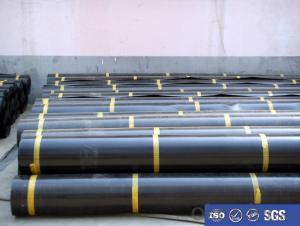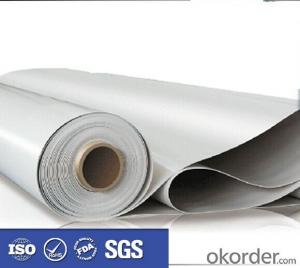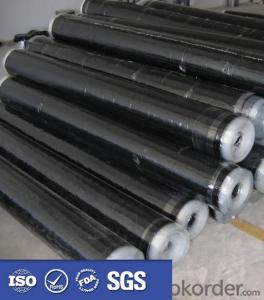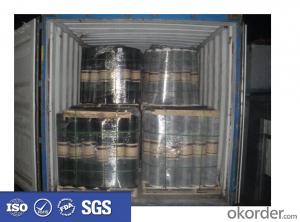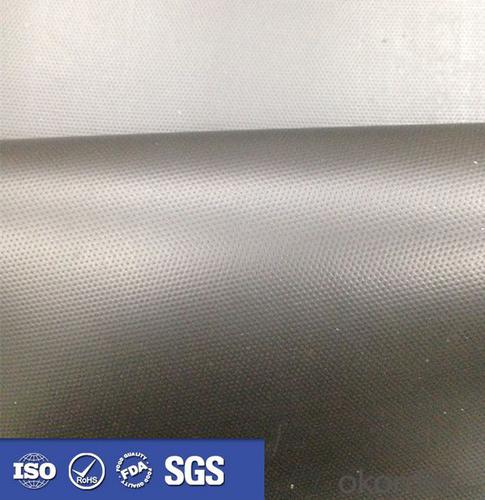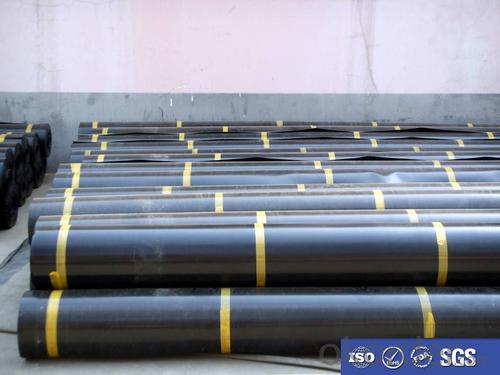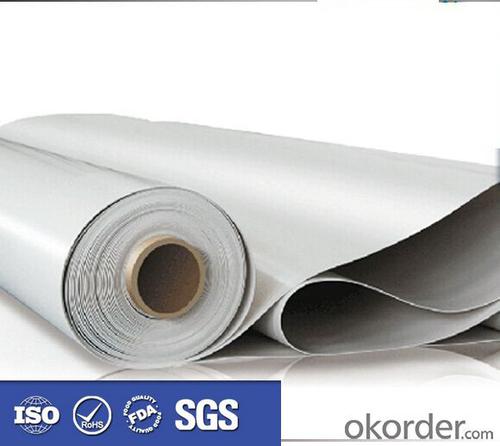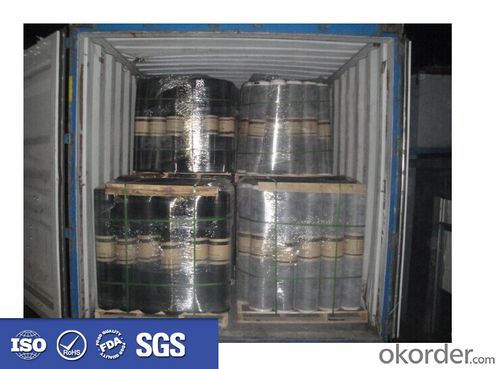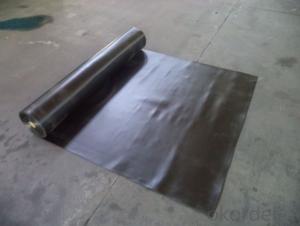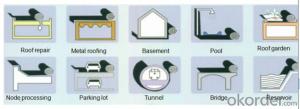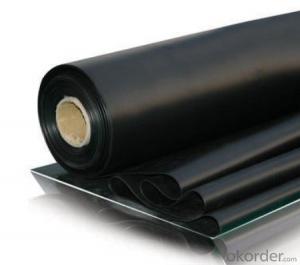EPDM Waterproof Membrane1.2mm Weldable
- Loading Port:
- Qingdao
- Payment Terms:
- TT OR LC
- Min Order Qty:
- 2000 m²
- Supply Capability:
- 8000000 m²/month
OKorder Service Pledge
OKorder Financial Service
You Might Also Like
Description Of EPDM Waterproof Membrane1.2mm Weldable:
Self adhesive waterproof rolling material:
thickness:1.2/1.5/2.0mm
length/roll:10/20m
width/roll:1.02m
Low temperature:-15 -20,-30
Main Features of EPDM Waterproof Membrane1.2mm Weldable:
1) High tear
2) High puncturing strength
3) Great temperature resistance.
4) High dimensional stability
Specifications of EPDM Waterproof Membrane1.2mm Weldable:
Material | EPDM Waterproof Membrane1.2mm Weldable |
Size | 1.2m (width)*20m (length) or customized, weldable type 2.05m or 4m width |
Thick | 1.2mm, 1.5mm, 2.0mm |
Type | Vulcanized & Weldable |
Pattern | Non-reinforced (homogeneous) |
Certificate | ISO9001/14001 |
Applications of EPDM Waterproof Membrane1.2mm Weldable:
1.It is widely used in civil and industry construction.
2.The waterproof,dampproof of the roofs,basements,toilets etc;
3.And the waterproofing of subway,underground,bridges,car parking,tunnels,reserviors,pool etc.
4.SBS modified bitumen waterproof membrane is specially suitable to the building waterproofing in cold area and to the buildings of changeable constructions
5.APP specially suitable to areas of high temperature and of strong sunshine.
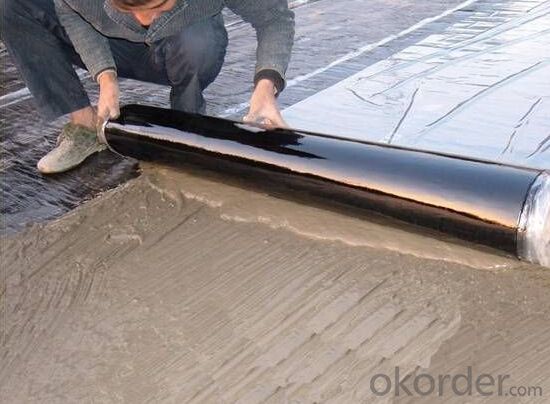


FAQ:
1. What are we supplying?
We are specialized in producing Colorful Asphalt Roof Shingle, SBS/APP modified bitumen waterproof membrane, Self adhesive bitumen waterproof membrane, PVC waterproofing membrane, EPDM rubber roofing membrane, Single Component Polyurethane Waterproof Coating, and Spray Polyurea Waterproof Coating.
2. How Many years experience do we have?
We have been exported to more than 20 countries in the past 15 years.
3. How long do we usually reply your request?
We always reply our customer within 24 hours.
- Q: Is a waterproofing membrane resistant to hydrocarbons or oils?
- Typically, waterproofing membranes are resistant to hydrocarbons and oils. The materials utilized in these membranes, such as bitumen or synthetic polymers, are specifically engineered to possess strong resistance against different chemicals, including hydrocarbons and oils. This resistance guarantees that the membrane remains efficient in obstructing water penetration even when confronted with these substances. Nevertheless, it is crucial to acknowledge that the resistance level may differ depending on the type and quality of the waterproofing membrane. It is advisable to consult the manufacturer or supplier to ascertain the precise resistance capabilities of a given waterproofing membrane.
- Q: Are waterproofing membranes resistant to UV rays?
- Yes, waterproofing membranes are designed to be resistant to UV rays. UV rays from the sun can degrade and damage many materials over time, including certain types of waterproofing membranes. To prevent this, manufacturers often incorporate UV stabilizers into the membranes during the production process. These stabilizers help to protect the membrane from the harmful effects of UV rays, such as fading, cracking, and deterioration. Additionally, some waterproofing membranes may have an outer layer or coating that provides an extra layer of UV protection. However, it is important to note that the level of UV resistance can vary depending on the type and quality of the waterproofing membrane, so it is advisable to consult the manufacturer's specifications and recommendations for the specific product being used.
- Q: Can a waterproofing membrane be used on EPDM roofs?
- Yes, a waterproofing membrane can be used on EPDM roofs. EPDM (ethylene propylene diene terpolymer) is a highly durable and flexible synthetic rubber roofing material commonly used for low-slope and flat roofs. While EPDM roofs are already waterproof, applying an additional waterproofing membrane can provide an extra layer of protection and enhance the roof's longevity. The waterproofing membrane can act as a barrier against water infiltration, preventing leaks and moisture damage. However, it is important to ensure that the waterproofing membrane is compatible with EPDM and follows the manufacturer's guidelines for installation to maintain the roof's integrity.
- Q: Can a waterproofing membrane be used on fiberglass surfaces?
- Yes, a waterproofing membrane can be used on fiberglass surfaces.
- Q: How does a waterproofing membrane compare to other waterproofing methods?
- Compared to other traditional waterproofing methods, a waterproofing membrane stands out in several ways: 1. Unmatched Protection: When it comes to keeping water out, a waterproofing membrane is unparalleled. Unlike waterproof paints or coatings, which may crack or peel, a membrane forms a continuous and seamless barrier that can withstand extreme weather conditions. 2. Long-Lasting: Designed to be durable, waterproofing membranes are made from materials like rubber, PVC, or modified bitumen that resist wear and tear. This ensures that they provide a reliable waterproofing solution for many years. 3. Versatility at its Best: Waterproofing membranes can be applied to various surfaces, including concrete, metal, and wood. They are suitable for a wide range of applications such as roofs, basements, foundations, and tunnels, making them ideal for both residential and commercial projects. 4. Flexible and Adaptable: Thanks to their flexibility, waterproofing membranes conform to the shape and contours of the surface they are applied to. This quality allows them to accommodate any structural movements or shifts, preventing potential cracks or gaps that could lead to water leakage. 5. Easy to Install: Professionals or experienced DIYers can easily install waterproofing membranes. The process involves rolling out the membrane onto the surface, adhering it with adhesive or heat-welding, and sealing the edges and seams. This simplicity of installation makes it a popular choice for new construction and retrofit projects alike. 6. Cost-Effective Investment: Although the initial cost of installing a waterproofing membrane may be higher compared to other methods, its long-term cost-effectiveness makes it a wise investment. The durability and longevity of the membrane result in fewer maintenance and repair costs over time, saving money in the long run. In conclusion, a waterproofing membrane surpasses other waterproofing methods in terms of protection, longevity, versatility, flexibility, ease of installation, and cost-effectiveness. Its ability to provide a continuous and reliable barrier against water intrusion makes it the preferred choice for many construction projects.
- Q: Can a waterproofing membrane be used in boat decks or marinas?
- Yes, a waterproofing membrane can be used in boat decks or marinas. It is commonly used to protect the underlying structure from water damage and provide a durable, watertight barrier that helps prevent leaks and deterioration.
- Q: Can a waterproofing membrane be used for underground parking garages?
- Yes, a waterproofing membrane can be used for underground parking garages. In fact, it is highly recommended to use a waterproofing membrane in these types of structures to prevent water infiltration and damage. Underground parking garages are prone to water seepage from the surrounding soil, and the constant exposure to moisture can lead to structural deterioration, corrosion of steel reinforcements, and the growth of mold and mildew. A waterproofing membrane acts as a barrier, preventing water from penetrating the walls and floors of the garage. It is applied to the exterior surfaces of the structure, providing a protective layer that keeps the interior dry and free from water-related issues. The membrane should be selected based on the specific requirements of the project, considering factors such as the type of construction materials, the groundwater conditions, and the anticipated level of water pressure. Additionally, proper installation techniques and regular maintenance are crucial to ensure the long-term effectiveness of the waterproofing system.
- Q: What is the typical installation process for a waterproofing membrane?
- The typical installation process for a waterproofing membrane involves several steps. First, the surface that needs to be waterproofed is thoroughly cleaned and prepared. This may involve removing any existing coatings, debris, or loose materials from the surface. It is important to ensure that the surface is smooth, clean, and free from any contaminants that could affect the adhesion of the membrane. Next, any cracks, holes, or imperfections in the surface are repaired. This may involve filling in cracks with a suitable filler or patching compound, and smoothing out any rough areas. It is crucial to have a solid and even surface to ensure the proper installation and effectiveness of the waterproofing membrane. Once the surface is prepared, a primer is often applied. The primer helps to improve the adhesion between the surface and the membrane. It is typically applied with a brush or roller, following the manufacturer's instructions. After the primer has dried, the waterproofing membrane is installed. There are different types of membranes available, such as sheet membranes or liquid-applied membranes. Sheet membranes are typically rolled out onto the surface and adhered using a suitable adhesive or mortar. Liquid-applied membranes are applied using a brush, roller, or spray equipment, creating a continuous and seamless barrier. During the installation process, it is important to ensure that the membrane is installed correctly, with proper overlap or seams, and that any penetrations or transitions are properly treated and sealed. This includes areas such as corners, edges, drains, and pipe penetrations, where additional detailing may be required to create a watertight seal. Once the membrane is installed, it is important to allow it to cure or dry according to the manufacturer's instructions. This ensures that the membrane reaches its full strength and waterproofing capabilities. Finally, after the membrane has cured, a protective layer or coating may be applied to further enhance the durability and longevity of the waterproofing system. This may involve applying a topcoat, sealant, or protective barrier to protect the membrane from UV rays, foot traffic, or other potential sources of damage. Overall, the typical installation process for a waterproofing membrane involves surface preparation, application of a primer, installation of the membrane, detailing and sealing, curing, and potentially applying a protective layer. It is important to follow the manufacturer's instructions and consult with a professional if necessary to ensure a proper and effective installation.
- Q: Can waterproofing membranes be used on concrete surfaces?
- Yes, waterproofing membranes can be used on concrete surfaces. Waterproofing membranes are designed to create a barrier against water penetration, and they are commonly used on concrete surfaces to protect them from water damage. These membranes are typically made of materials such as rubber, PVC, or bitumen, and they are applied to the concrete surface in a liquid or sheet form. Once applied, the membrane forms a continuous and durable waterproof layer that prevents water from seeping into the concrete. This is particularly beneficial in areas that are prone to water exposure, such as basements, bathrooms, or exterior concrete structures. Waterproofing membranes can effectively extend the lifespan of concrete surfaces by preventing water-related issues such as cracking, spalling, or mold growth.
- Q: Can a waterproofing membrane be used on tunnels?
- Yes, a waterproofing membrane can be used on tunnels. Tunnels are often subjected to high levels of moisture, groundwater infiltration, and potential leaks. Therefore, it is crucial to protect them from water damage and ensure their long-term structural integrity. Waterproofing membranes are commonly used in tunnel construction to prevent water penetration and provide an effective barrier against moisture. These membranes are designed to be durable, flexible, and resistant to various environmental conditions, making them suitable for use in tunnels. They can be applied to the tunnel walls, roof, and floor to create a waterproof seal, ensuring that the tunnel remains dry and protected from water-related issues such as corrosion, deterioration, and mold growth. Additionally, waterproofing membranes can also help in reducing maintenance costs and extending the lifespan of the tunnel infrastructure.
Send your message to us
EPDM Waterproof Membrane1.2mm Weldable
- Loading Port:
- Qingdao
- Payment Terms:
- TT OR LC
- Min Order Qty:
- 2000 m²
- Supply Capability:
- 8000000 m²/month
OKorder Service Pledge
OKorder Financial Service
Similar products
Hot products
Hot Searches
Related keywords

